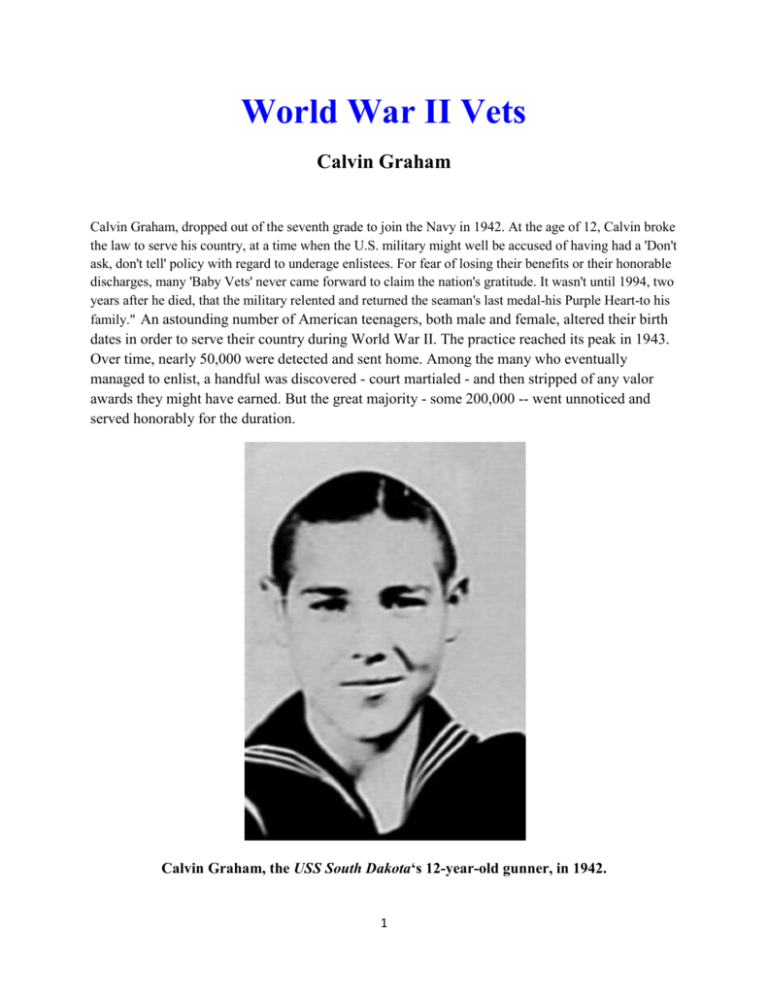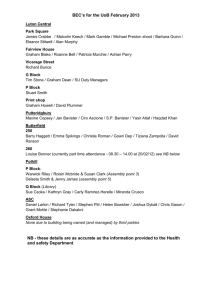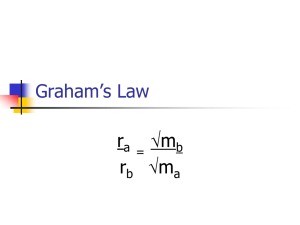Vets – WWII Calvin Graham
advertisement

World War II Vets Calvin Graham Calvin Graham, dropped out of the seventh grade to join the Navy in 1942. At the age of 12, Calvin broke the law to serve his country, at a time when the U.S. military might well be accused of having had a 'Don't ask, don't tell' policy with regard to underage enlistees. For fear of losing their benefits or their honorable discharges, many 'Baby Vets' never came forward to claim the nation's gratitude. It wasn't until 1994, two years after he died, that the military relented and returned the seaman's last medal-his Purple Heart-to his family." An astounding number of American teenagers, both male and female, altered their birth dates in order to serve their country during World War II. The practice reached its peak in 1943. Over time, nearly 50,000 were detected and sent home. Among the many who eventually managed to enlist, a handful was discovered - court martialed - and then stripped of any valor awards they might have earned. But the great majority - some 200,000 -- went unnoticed and served honorably for the duration. Calvin Graham, the USS South Dakota‘s 12-year-old gunner, in 1942. 1 ~~~~~~~~~~~~~~~~~~~~~ With powerful engines, extensive firepower and heavy armor, the newly christened battleship USS South Dakota steamed out of Philadelphia in August of 1942 spoiling for a fight. The crew was made up of “green boys”— new recruits who enlisted after the Japanese bombing of Pearl Harbor — who had no qualms about either their destination or the action they were likely to see. Brash and confident, the crew couldn’t get through the Panama Canal fast enough, and their captain, Thomas Gatch, made no secret of the grudge he bore against the Japanese. “No ship more eager to fight ever entered the Pacific,” one naval historian wrote. In less than four months, the South Dakota would limp back to port in New York for repairs to extensive damage suffered in some of World War II’s most ferocious battles at sea. The ship would become one of the most decorated warships in U.S. Navy history and acquire a new moniker to reflect the secrets it carried. The Japanese, it turned out, were convinced the vessel had been destroyed at sea, and the Navy was only too happy to keep the mystery alive — stripping the South Dakota of identifying markings and avoiding any mention of it in communications and even sailors’ diaries. When newspapers later reported on the ship’s remarkable accomplishments in the Pacific Theater, they referred to it simply as “Battleship X.” That the vessel was not resting at the bottom of the Pacific was just one of the secrets Battleship X carried through day after day of hellish war at sea. Aboard was a gunner from Texas who would soon become the nation’s youngest decorated war hero. Calvin Graham, the fresh-faced seaman who had set off for battle from the Philadelphia Navy Yard in the summer of 1942, was only 12 years old. Graham was just 11 and in the sixth grade in Crockett, Texas, when he hatched his plan to lie about his age and join the Navy. One of seven children living at home with an abusive stepfather, he and an older brother moved into a cheap rooming house, and Calvin supported himself by selling newspapers and delivering telegrams on weekends and after school. Even though he moved out, his mother would occasionally visit—sometimes to simply sign his report cards at the end of a semester. The country was at war, however, and being around newspapers afforded the boy the opportunity to keep up on events overseas. “I didn’t like Hitler to start with,” Graham later told a reporter. When he learned that some of his cousins had died in battles, he knew what he wanted to do with his life. He wanted to fight. “In those days, you could join up at 16 with your parents’ consent, but they preferred 17,” Graham later said. But he had no intention of waiting five more years. He began to shave at age 11, hoping it would somehow make him look older when he met with military recruiters. Then he lined up with some buddies (who forged his mother’s signature and stole a notary stamp from a local hotel) and waited to enlist. At 5-foot-2 and just 125 pounds, Graham dressed in an older brother’s clothes and fedora and practiced “talking deep.” What worried him most was not that an enlistment officer would spot the forged signature. It was the dentist who would peer into the mouths of potential recruits. “I knew he’d know how young I was by my teeth,” Graham recalled. He lined up behind a couple 2 of guys he knew who were already 14 or 15, and “when the dentist kept saying I was 12, I said I was 17.” At last, Graham played his ace, telling the dentist that he knew for a fact that the boys in front of him weren’t 17 yet, and the dentist had let them through. “Finally,” Graham recalled, “he said he didn’t have time to mess with me and he let me go.” Graham maintained that the Navy knew he and the others on line that day were underage, “but we were losing the war then, so they took six of us.” It wasn’t uncommon for boys to lie about their age in order to serve. Ray Jackson, who joined the Marines at 16 during World War II, founded the group Veterans of Underage Military Service in 1991, and it listed more than 1,200 active members, including 26 women. “Some of these guys came from large families and there wasn’t enough food to go around, and this was a way out,” Jackson told a reporter. “Others just had family problems and wanted to get away.” Calvin Graham told his mother he was going to visit relatives. Instead, he dropped out of the seventh grade and shipped off to San Diego for basic training. There, he said, the drill instructors were aware of the underage recruits and often made them run extra miles and lug heavier packs. Just months after her christening in 1942, the USS South Dakota was attacked relentlessly in the Pacific. By the time the USS South Dakota made it to the Pacific, it had become part of a task force alongside the legendary carrier USS Enterprise (the “Big E”). By early October 1942, the two ships, along with their escorting cruisers and destroyers, raced to the South Pacific to engage in the fierce fighting in the battle for Guadalcanal. After they reached the Santa Cruz Islands on October 26, the Japanese quickly set their sights on the carrier and launched an air attack that easily penetrated the Enterprise’s own air patrol. The carrier USS Hornet was repeatedly torpedoed and sank off Santa Cruz, but the South Dakota managed to protect Enterprise, destroying 26 enemy planes with a barrage from its antiaircraft guns. 3 Standing on the bridge, Captain Gatch watched as a 500-pound bomb struck the South Dakota’s main gun turret. The explosion injured 50 men, including the skipper, and killed one. The ship’s armor was so thick, many of the crew were unaware they’d been hit. But word quickly spread that Gatch had been knocked unconscious. Quick-thinking quartermasters managed to save the captain’s life—his jugular vein had been severed, and the ligaments in his arms suffered permanent damage—but some onboard were aghast that he didn’t hit the deck when he saw the bomb coming. “I consider it beneath the dignity of a captain of an American battleship to flop for a Japanese bomb,” Gatch later said. The ship’s young crew continued to fire at anything in the air, including American bombers that were low on fuel and trying to land on the Enterprise. The South Dakota was quickly getting a reputation for being wild-eyed and quick to shoot, and Navy pilots were warned not to fly anywhere near it. The South Dakota was fully repaired at Pearl Harbor, and Captain Gatch returned to his ship, wearing a sling and bandages. Seaman Graham quietly became a teenager, turning 13 on November 6, just as Japanese naval forces began shelling an American airfield on Guadalcanal Island. Steaming south with the Enterprise, Task Force 64, with the South Dakota and another battleship, the USS Washington, took four American destroyers on a night search for the enemy near Savo Island. There, on November 14, Japanese ships opened fire, sinking or heavily damaging the American destroyers in a four day engagement that became known as the Naval Battle of Guadalcanal. Later that evening the South Dakota encountered eight Japanese destroyers; with deadly accurate 16-inch guns, the South Dakota set fire to three of them. “They never knew what sank ‘em,” Gatch would recall. One Japanese ship set its searchlights on the South Dakota, and the ship took 42 enemy hits, temporarily losing power. Graham was manning his gun when shrapnel tore through his jaw and mouth; another hit knocked him down, and he fell through three stories of superstructure. Still, the 13 year-old made it to his feet, dazed and bleeding, and helped pull other crew members to safety while others were thrown by the force of the explosions, their bodies aflame, into the Pacific. “I took belts off the dead and made tourniquets for the living and gave them cigarettes and encouraged them all night,” Graham later said. ”It was a long night. It aged me.” The shrapnel had knocked out his front teeth, and he had flash burns from the hot guns, but he was “fixed up with salve and a coupla stitches,” he recalled. “I didn’t do any complaining because half the ship was dead. It was a while before they worked on my mouth.” In fact, the ship had casualties of 38 men killed and 60 wounded. Regaining power, and after afflicting heavy damage to the Japanese ships, the South Dakota rapidly disappeared in the smoke. Captain Gatch would later remark of his “green” men, “Not one of the ship’s company flinched from his post or showed the least disaffection.” With the Japanese Imperial Navy under the impression that it had sunk the South Dakota, the legend of Battleship X was born. 4 After the Japanese Imperial Navy falsely believed it had sunk the South Dakota in November, 1942, the American vessel became known as “Battleship X.” Photo: Wikimedia In mid-December, the damaged ship returned to the Brooklyn Navy Yard for major repairs, where Gatch and his crew were profiled for their heroic deeds in the Pacific. Calvin Graham received a Bronze Star for distinguishing himself in combat, as well as a Purple Heart for his injuries. But he couldn’t bask in glory with his fellow crewmen while their ship was being repaired. Graham’s mother, reportedly having recognized her son in newsreel footage, wrote the Navy, revealing the gunner’s true age. Graham returned to Texas and was thrown in a brig at Corpus Christi, Texas, for almost three months. Battleship X returned to the Pacific and continued to shoot Japanese planes out of the sky. Graham, meanwhile, managed to get a message out to his sister Pearl, who complained to the newspapers that the Navy was mistreating the “Baby Vet.” The Navy eventually ordered Graham’s release, but not before stripping him of his medals for lying about his age and revoking his disability benefits. He was simply tossed from jail with a suit and a few dollars in his pocket—and no honorable discharge. 5 Back in Houston, though, he was treated as a celebrity. Reporters were eager to write his story, and when the war film Bombadier premiered at a local theater, the film’s star, Pat O’Brian, invited Graham to the stage to be saluted by the audience. The attention quickly faded. At age 13, Graham tried to return to school, but he couldn’t keep pace with students his age and quickly dropped out. He married at age 14, became a father the following year, and found work as a welder in a Houston shipyard. Neither his job nor his marriage lasted long. In 1950, 17 years old and divorced, and with no service record, Graham was about to be drafted when he enlisted in the Marine Corps. He soon broke his back in a fall, for which he received a 20 percent serviceconnected disability. The only work he could find after that was selling magazine subscriptions. When President Jimmy Carter was elected, in 1976, Graham began writing letters, hoping that Carter, “an old Navy man,” might be sympathetic. All Graham had wanted was an honorable discharge so he could get help with his medical and dental expenses. “I had already given up fighting” for the discharge, Graham said at the time. “But then they came along with this discharge program for [Vietnam-era] deserters. I know they had their reasons for doing what they did, but I figure I damn sure deserved [an honorable discharge] more than they did.” In 1977, Texas Senators Lloyd Bentsen and John Tower introduced a bill to give Graham his discharge, and in 1978, Carter announced that it had been approved and that Graham’s medals would be restored, with the exception of the Purple Heart. Ten years later, President Ronald Reagan signed legislation approving disability benefits for Graham. [Source: http://blogs.smithsonianmag.com/history/2012/12/the-boy-who-became-a-world-warii-veteran-at-13-years-old/ Dec 2012 ++] 6









